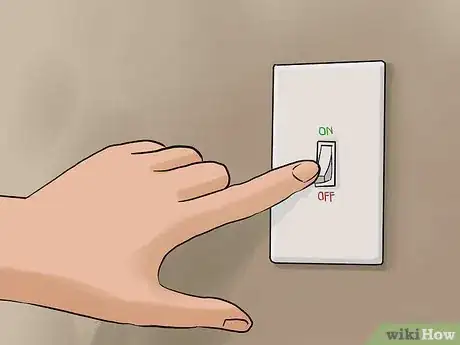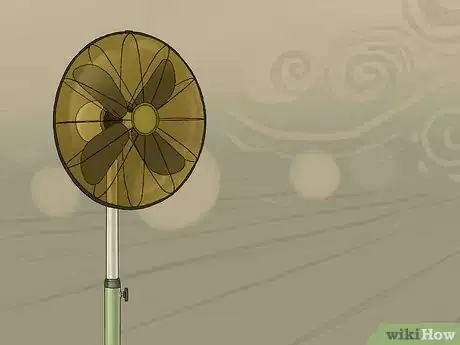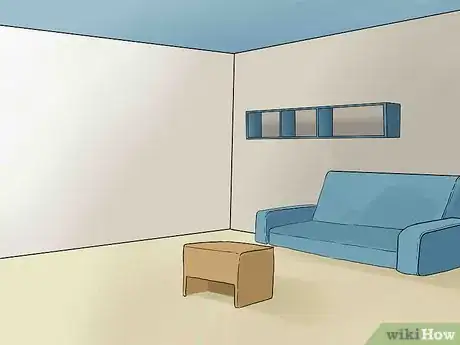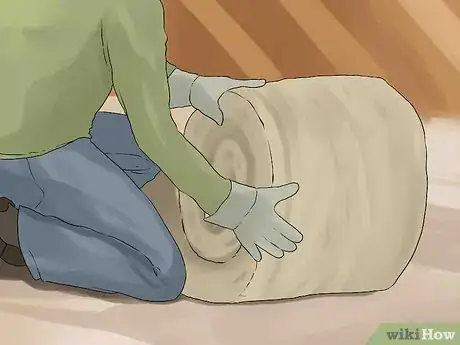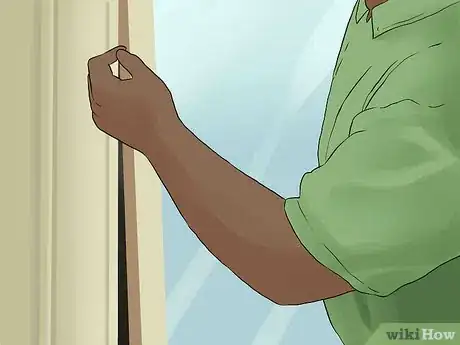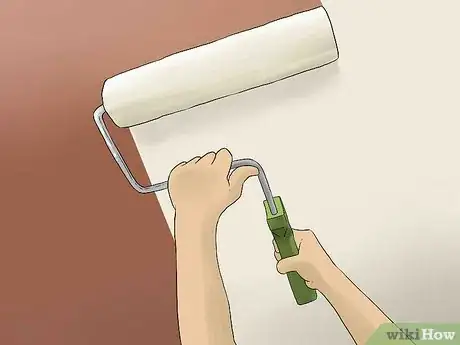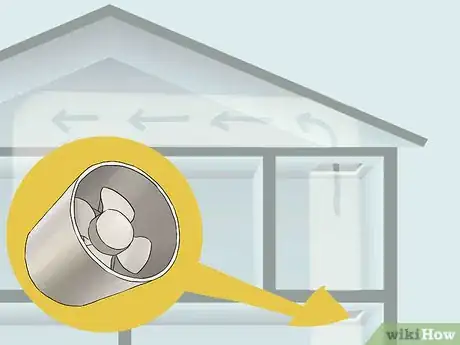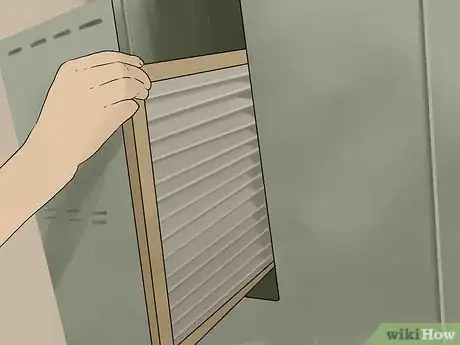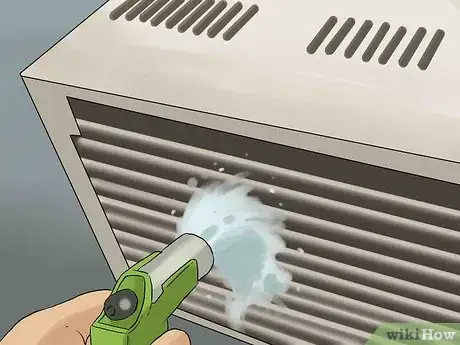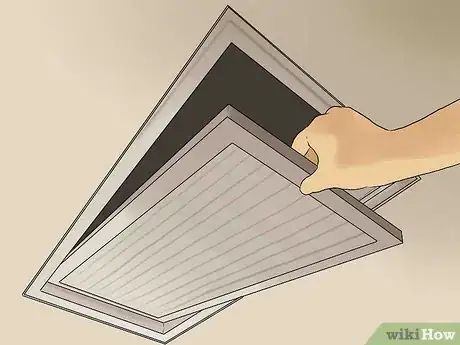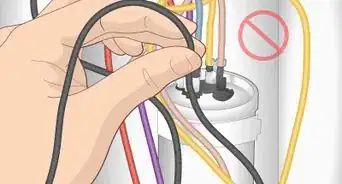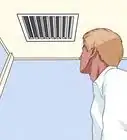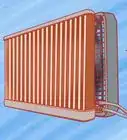This article was co-authored by Walter Brant. Walter Brant is a wikiHow community member and contributor who has been repairing and restoring houses with over 30 years of experience. He works with homeowners to make a wide variety of improvements to make their homes more comfortable and liveable.
There are 14 references cited in this article, which can be found at the bottom of the page.
This article has been viewed 431,154 times.
Suffering in summer heat in the upstairs bedroom? No need – with a few housing hacks, you can feel like you're drinking mojitos in the cool breeze of spring in no time. We'll cover making little changes, large-scale structural changes, and improving the existing system in your house. After all, your house is already air-conditioned, so it'll be easy.
Steps
Making Small-Scale Changes
-
1Close the shades and drapes. Heat gets into the house from sunlight through the windows. Pulling down shades and drawing drapes helps block the sunlight.[1] Think of the room like your car parked in a hot parking lot – forever.[2]
- If you're interested, buy some quality heat-blocking shades for the windows. Wood shades or thicker, light-colored drapes will do the trick. They may not look very good, so add a curtain on top of the shades to cover them up if desired.
-
2Turn off the lights. If you're still rocking old school, high-wattage light bulbs, you've probably noticed how easily they heat up. And while it may seem insignificant, their power really does add up, especially if you have several. Turn them off and keep them off as much as possible.[3]
- Desperately need lights? Look into energy-saving, dimmer bulbs that don't give off as much heat (and are better for the environment). LED lights are getting cheaper and cheaper, too.[4]
Advertisement -
3Open upstairs registers and close downstairs registers. Opening upstairs cold air supply registers fully and all but closing downstairs air supply registers helps direct the cold air upstairs. You are literally rerouting the circulation of the air pushed out through your air conditioner.[5]
- Be careful not to fully close all downstairs air supply registers. Enough air must go through the air conditioner in order to work efficiently.
-
4Move furniture from registers. Rearrange furniture so that air supply registers are fully uncovered. Also remove blockages from air returns in all rooms. This ensures that good air circulation occurs in the upper floor.[6]
- Take these items and move them to open walls. By placing things like bookshelves or tapestries against the walls, you can help keep cool from escaping.
-
5Use floor fans. Floor fans help circulate air in a room, especially if placed well. They help prevent the cold air from settling near the floor of the upstairs rooms, whisking it up in an airy cycle. Place it in the corner where it can move the air across the room via an unobstructed path (tidy up a bit if need be). Then it can mix all the air, lowering the temperature.
-
6Get rid of the clutter. With fewer objects in the room, air is allowed to flow, not get stale and stagnant, and get cooler. Tidy up the room, getting as much surface area in the open as possible. And now you can place your fan in the best possible place in the room, circulating the air around and around. A clear space can feel several degrees cooler.[9]
Making Large-Scale Changes
-
1Add attic insulation. Attics need R30 insulation (at least) to keep heat out in summer and heat indoors in winter. In the long run, you can save money in both seasons by insulating your attic. Just make sure you get the right insulation; if it is not rated high enough or not thick enough it can allow the summer heat down into the house.[10] [11]
- If you have an attic, buy half inch plywood and lay it in between the trusses over the insulation. It will give you a walking/storage surface as well as enhancing your ability to block heat transfer. Insulation alone doesn't stop the heat from going into your house; it only delays the transfer until the attic cools at night when the heat flow slows down.
-
2Fix your windows. Leaking windows and single pane glass let cold out and heat in. Consider Low E glass for window replacements and double or even triple-paned windows. This will keep you cooler in summer by not letting the cold air warm up and warmer in the summer by not letting the hot air "leak" out.[12]
- If there are any cracks or space between the windows and the walls, that's hot and cool air escaping like sands through an hourglass. Even if you don't upgrade your glass, make sure to cover any structural spots that need taken care of.
-
3Do some energy-conscious redecorating. There are a number of things you can do to your house that can keep it cool. Consider painting walls white or another really light color as light doesn't absorb a lot of heat like darker colors do. This goes for your roof, too – though a white roof may seem a little less than fashionable.[13]
- You could also consider adding awnings or even extending the roof line so that the sun, in the summer, is blocked by the roof and is prevented from entering the windows.
-
4Add duct or ceiling fans. If the air conditioner is big enough to cool the whole house then air circulation is most likely the trouble. Hot air rises and cold air sinks. By replacing the register covers with register/fan units more cold air is forced out of the upstairs ducts. These units can be purchased at large hardware stores or home-centers.
- Try adding a couple of ceiling fans in the upstairs rooms or over a large open 2 story room such as a loft. Many fans have a switch that controls how it works – one blows air down and the other sucks air up. You want the fan to suck the cold air up and spread it over the house again.
Improving Your Existing System
-
1Replace furnace filters. Blocked filters prevent cold air circulation. Replace filters at least every three months to keep them working at 100%. Go into your basement and you'll find the filter on the bottom of the filter casing. Make sure the new filter you bought fits your HVAC unit.[14]
- You can do this yourself. All you need to do is take out the old filter and place in the new one, making sure the arrows on the sides are pointing in the right direction (they're to indicate airflow. It's a job that takes a whole 30 seconds.[15]
-
2If applicable, clean your outdoor AC unit. Rinse the outside unit with a garden hose (gently) to remove dirt from the coils. Remove leaves and debris from inside the fan area. The unit MUST be off to do this. It's possible gunk and grime is keeping your air conditioner from running at full potential.
-
3Make sure soffit vents are working and not blocked. A hot attic makes for a hot upstairs. Add a ridge vent or power vents if needed to bring down the attic temperature. If you're not sure how they're operating, don't hesitate to call in a professional.[16]
- Soffit vents aren't only for your comfort; they're to lengthen the lifespan of your roof. So will it could be an expense now, it could save you thousands in the long run (a roof that constantly overheats is not a long-lasting roof).[17]
-
4Get a pressure check. The air conditioner may leak small amounts of refrigerant over time. A heating and cooling contractor can check and refill the air conditioner, if needed, to maximize cooling.
- If you're quite handy, you can do this yourself. Take a look at wikiHow's Charge a Home Air Conditioner for more information.
-
5Call a professional. Many heating and cooling contractors will do a survey and make recommendations for a small fee. Always get more than one opinion and work with reputable professionals that have references. Check the Better Business Bureau (US) before working with anyone as this can be an expensive endeavor that you want to get done right.
- Air conditioners should be placed close to the ceiling as cold air sinks and hot air rises. It needs to be placed in a well ventilated place to ensure maximum results – if this does not describe your air conditioner, consider getting it moved for more efficient results.
Expert Q&A
-
QuestionHow can I cool the upstairs of a 2-story house without AC?
 Walter BrantWalter Brant is a wikiHow community member and contributor who has been repairing and restoring houses with over 30 years of experience. He works with homeowners to make a wide variety of improvements to make their homes more comfortable and liveable.
Walter BrantWalter Brant is a wikiHow community member and contributor who has been repairing and restoring houses with over 30 years of experience. He works with homeowners to make a wide variety of improvements to make their homes more comfortable and liveable.
Handyman Cover your windows with blinds or shades to prevent sunlight from coming inside and heating the space.
Cover your windows with blinds or shades to prevent sunlight from coming inside and heating the space. -
QuestionShould I keep one window open when the AC is on for ventilation?
 Community AnswerNo, when the AC is running there is no need to open a window. Ventilation will occur from the AC itself.
Community AnswerNo, when the AC is running there is no need to open a window. Ventilation will occur from the AC itself. -
QuestionShould the upstairs doors be open or closed to keep it cooler?
 Community AnswerYou may keep the doors open to create a cooler space.
Community AnswerYou may keep the doors open to create a cooler space.
Warnings
- Do not clean the outside unit if there is any uncertainty about how to do this. Damage and/or injury can result. The unit must be turned OFF before removing leaves or debris. When rinsing the coils, NO water must enter the control box.⧼thumbs_response⧽
References
- ↑ Walter Brant. Handyman.
- ↑ https://www.consumerreports.org/energy-efficiency/beat-the-heat-with-window-coverings/
- ↑ https://www.energy.gov/energysaver/save-electricity-and-fuel/lighting-choices-save-you-money/when-turn-your-lights
- ↑ http://www.cnet.com/news/led-there-be-light-we-pick-the-best-bulb-upgrades-for-your-buck/
- ↑ https://www.myenergymonster.com/ct/%E2%80%8Bhow-cool-room-upstairs-without-breaking-bank-%E2%80%8B/
- ↑ https://www.myenergymonster.com/ct/%E2%80%8Bhow-cool-room-upstairs-without-breaking-bank-%E2%80%8B/
- ↑ https://www.apartmenttherapy.com/the-best-way-to-use-a-fan-119962
- ↑ Walter Brant. Handyman.
- ↑ https://www.apartmenttherapy.com/10-ways-to-save-energy-when-ai-120022
- ↑ Walter Brant. Handyman.
- ↑ https://www.thisoldhouse.com/discussions/topic/will-adding-insulation-to-attic-keep-my-house-cooler
- ↑ https://www.thisoldhouse.com/ideas/hot-weather-tips-windows
- ↑ https://www.nrel.gov/docs/legosti/old/15771.pdf
- ↑ https://www.angieslist.com/articles/5-reasons-change-your-furnace-filter.htm
- ↑ http://www.lowes.com/cd_Change+Furnace+Filter_1365096050541_
- ↑ https://www.centralhtg.com/blog/second-floor-is-too-hot
- ↑ http://www.city-data.com/forum/house/1630103-do-soffit-vents-ridge-vent-really.html
About This Article
To keep the upstairs of your air conditioned home cooler, close the shades and curtains, and keep the lights turned off as much as possible. If you’re using high-wattage bulbs, consider switching to LED or other energy-saving bulbs that give off less heat. Additionally, use floor fans to help circulate the air and prevent it from settling near the floor. Alternatively, create an instant source of cold air by placing a bowl of ice cubes in front of the fan. For more advice, including how to keep your home cooler by painting your walls and fixing your windows, keep reading.

